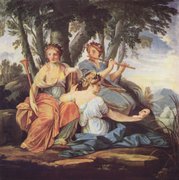Muse
In Greek mythology, the Muses (Greek Μουσαι, Mousai) are nine archaic goddesses who embody the right evocation of myth, inspired through remembered and improvised song and traditional "music" and dances. They were water nymphs, associated with the springs of Helicon and Pieris. They are sometimes called Pierides from their association with the spring of Pieres. The Olympian system set Apollo as their leader, Apollon Mousagetes. more...
According to Hesiod's Theogony, they are the daughters of Zeus, king of the gods, and Mnemosyne, goddess of memory. For Alcman and Mimnermus, they were even more primordial, springing from Uranus and Gaia. Pausanias supports that there were two generations of Muses; the first being daughters of Uranus and Gaia, the second from Zeus and Mnemosyne. Another rarer belief is that they are daughters of Harmonia (the daughter of Aphrodite and Ares) which contradicts with the myth in which they were dancing in the marriage of Harmonia and Cadmus.
Compare the Roman inspiring nymphs of springs, the Camenae.
Muses in myth
According to Pausanias there were three original Muses: Aoide ("song", "voice"), Melete ("practice" or "occasion") and Mneme ("memory") (Paus. 9.29.1). Together, they form the complete picture of the preconditions of poetic art in cult practice. In Delphi three Muses were worshipped as well but with other names: Nete , Mesi and Hypate which are the names of the three chords of the ancient musical instrument lyre
In later tradition, the fourth Muse, Arche, was also considered.
The canonical nine Muses are:
- Calliope (epic poetry)
- Euterpe (music)
- Clio (history)
- Erato (lyrics/love poetry)
- Melpomene (tragedy)
- Polyhymnia (sacred poetry)
- Terpsichore (dancing)
- Thalia (comedy)
- Urania (astronomy)
Together, they form a complete picture of the subjects proper to poetic art in the archaic period. However, the association of specific muses with specific art forms is a later innovation.
In Roman, Renaissance and Neoclassical art, Muses depicted in sculptures or paintings are often distinguished by certain props or poses, as emblems. Euterpe (music) carries a flute; Calliope (epic poetry) carries a writing tablet; Clio (history) carries a scroll and books; Erato (lyric poetry) is often seen with a lyre and a crown of roses; Melpomene (tragedy) is often seen with a tragic mask; Polyhymnia (sacred poetry) is often seen with a pensive expression; Terpsichore (dancing) is often seen dancing and carrying a lyre; Thalia (comedy) is often seen with a comic mask; and Urania (astronomy) carries a staff pointed at a celestial globe.
Function in Society
Greek mousa is a common noun as well as a type of goddess: it literally means "song" or "poem". In Pindar, to "carry a mousa" is "to sing a song". The word is probably derived from the Indo-European root *men-, which is also the source of Greek Mnemosyne, Latin Minerva, and English "mind", "mental" and "memory".
The Muses were therefore both the embodiments and sponsors of performed metrical speech: mousike, whence "music"; was "the art of the Muses". In the archaic period, before the wide-spread availability of books, this included nearly all of learning: the first Greek book on astronomy, by Thales, was set in dactylic hexameter, as were many works of pre-Socratic philosophy; both Plato and the Pythagoreans explicitly included philosophy as a sub-species of mousike (Strabo 10.3.10). Herodotus, whose primary medium of delivery was public recitation, named each one of the nine books of his Histories after a different Muse.
Read more at Wikipedia.org




